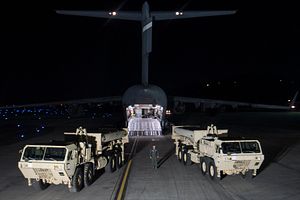The Terminal High Altitude Area Defense (THAAD) system has now officially gone into operation in South Korea. The purpose of THAAD, as The Diplomat has previously explained, is to detect and destroy enemy ballistic missiles, such as the ones North Korea is currently fielding.
With the introduction of the THAAD system in South Korea, the United States is certainly in a better position to respond to North Korean provocations such as a missile or nuclear test with military force. This could easily be accomplished with, for example, the Carl Vinson strike group now sitting off the North Korean coast. Although the THAAD system is perfect for shooting down incoming enemy ballistic missiles, that however is only half of the equation. North Korea does indeed have thousands of ballistic missiles from short- to long-range systems, which are constantly being tested and upgraded, but they also command an enormous number of long range artillery pieces that they keep just on the other side of the demilitarized zone, in striking range of Seoul. THAAD is not designed to intercept these artillery shells, which Pyongyang would undoubtedly unleash on disputed border islands or Seoul itself following any sort of attack on any of its assets.
Seoul is one of the world’s most important economic hubs and is a leader in the Asia-Pacific region. Any type of attack by North Korea would be met with huge uncertainty and fear in the world economy. This alone may give pause to the United States in instigating a strike as a war would most certainly affect its own economy and create widespread instability. On top of that, President Donald J. Trump campaigned saying that he would do everything in his power to revitalize the U.S. economy and work for the common man. Concerning the Korean Peninsula, however, he said in January that that under him, the United States would not allow North Korea to achieve the capability to strike the United States mainland. Economics aside, the costs of such an attack may, at least in the minds of U.S. leaders, outweigh the risks of allowing Pyongyang to field a functional nuclear delivery system.
North Korea is perhaps only a year away from testing its first real intercontinental ballistic missile (ICBM). In the Cold War, Russia and the United States relied on the principle of mutually assured destruction (MAD) initially, which states that any attack by either nation would be met with an equal attack on the other, ensuring that if one nation attacked the other, both nations would be destroyed. The philosophy behind detente was that neither nation had more strategic power over the other ensuring that a strategic balance was kept. When dealing with North Korea, there are no such principles at work. Kim Jong-un plays by a different set of rules and has proven to be an unpredictable geopolitical decision-maker. This predicament causes great concern in the west, particularly among lawmakers and military officials in Washington. If the United States cannot rely on any mutual understanding between the two countries to avoid a devastating attack, it may wish to remove the threat all together. In strategic terms, spending resources now to remove the possible threat North Korea may pose in the future to the U.S. mainland may be a more viable option than waiting until after an attack.
The introduction of THAAD in South Korea gives the United States added confidence to defend against any possible North Korean ballistic missile attacks. It helps ease the minds of military leaders in the region and gives more strategic stability to South Korea. However, it is not likely that the introduction of THAAD means that the United States has now decided to respond to North Korea with military force. The consequences of such an action would be catastrophic since Pyongyang can respond with massive force that U.S. cannot reliably defend against. As time ticks on however, North Korea will continue to upgrade its missile systems and work towards a deliverable nuclear weapon. There will come a time when North Korea is a direct threat to the United States. At this point, Washington may be forced into action.
Ryan Barenklau is the CEO of Strategic Sentinel.
































